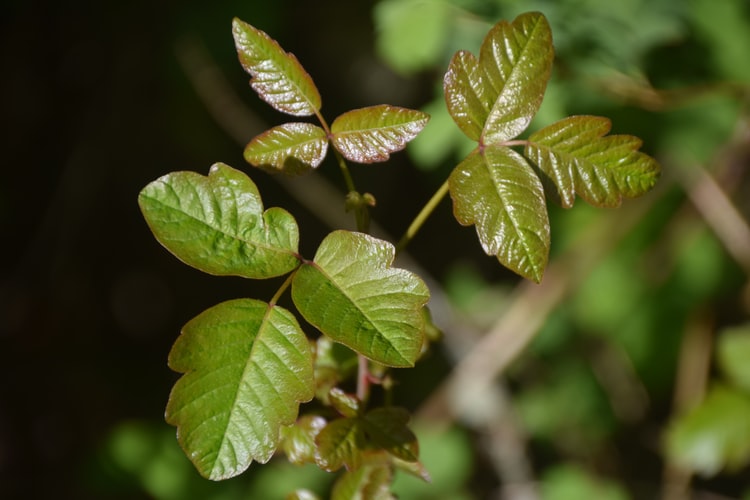Understanding the natural world that surrounds you can offer not only immense pleasure but can also equip you with crucial knowledge for self-protection. It’s essential to recognize the diverse plant species, especially those that can potentially pose a threat. Among nature’s bounty, there are some common poisonous plants that, when identified, can prevent possible allergic reactions and skin irritations. This blog post will guide readers through some of these common harmful plants and the identifying traits that set them apart.
Contents
Poison Ivy

Poison ivy, a notorious plant known for causing severe skin irritation, thrives across North America. It is well recognized by its characteristic ‘leaves of three’ pattern. However, its appearance can vary dramatically based on the local environment, and it can grow as a shrub or climbing vine. During spring and summer, poison ivy dons a glossy, green color, while autumn brings out a striking red hue.
Urushiol oil, the primary irritant in poison ivy, is present in all parts of the plant. When humans come into contact with this oil, it triggers an allergic reaction that can result in a rash, blistering, and intense itching. A critical point to remember is that urushiol remains potent even after the plant dies, making year-round identification crucial.
Poison Oak

Like its cousin, poison ivy, poison oak has a similar appearance and equally irritating effects. This plant can be identified by its lobed leaves, which resemble the leaves of an oak tree – hence its name. Unlike poison ivy, poison oak changes color and may even lose its leaves seasonally, making it more difficult to identify.
Also, containing urushiol, poison oak can cause a skin reaction akin to poison ivy. The reaction usually includes itching, redness, and swelling, which may progress to blisters if the skin has been in extensive contact with the plant. This plant is a resilient survivor and can thrive in various environments, adding to its danger quotient.
Poison Sumac

Poison sumac is another plant that contains urushiol, albeit in much higher concentrations than either poison ivy or poison oak. This plant can be distinguished by its red stem and clusters of 7-13 leaves, with each leaf comprising of smooth edges. Despite its innocent appearance, it packs quite a punch when it comes to skin irritation.
Compared to other urushiol-containing plants, the skin irritation caused by poison sumac can be far more severe. Initial symptoms may include redness, itching, and swelling, eventually leading to painful blisters and a rash. Growing primarily in wet, swampy areas, it’s a plant that demands respect and caution.
Wild Parsnip

Hidden in the veil of its beautiful yellow flowers, wild parsnip conceals a harmful secret. This plant, often found along roadsides and in pastures, can grow up to four feet tall and is easily identified by its grooved stems. Despite its inviting appearance, wild parsnip can cause severe skin reactions, especially when the skin is exposed to sunlight after coming in contact with the plant’s sap.
Known for its phototoxic effects, the sap of wild parsnip can cause phytophotodermatitis – a skin condition where exposure to the sap under sunlight results in severe burns, similar to a second-degree sunburn. Symptoms may range from redness and rash to blistering. The scars from these burns can last for several months or even years, underscoring the importance of recognizing and avoiding this plant.
Giant Hogweed

Giant hogweed, an invasive species, has garnered attention due to its harmful effects and imposing stature. It can grow up to 14 feet tall with thick, bristly stems and large white flower clusters that can reach 2.5 feet across. Though this colossal plant may seem intriguing due to its size, its sap poses a significant danger.
Contact with giant hogweed’s sap, followed by exposure to sunlight, can lead to a severe skin reaction, similar to wild parsnip. The sap can cause painful burns and blisters, potentially resulting in permanent scars. More alarmingly, if the sap comes into contact with the eyes, it can lead to temporary or even permanent blindness. This reinforces the importance of treating this plant with extreme caution.
Stinging Nettle

Don’t let the benign appearance of the stinging nettle fool you; this plant has a notorious reputation for causing immediate discomfort upon contact. The heart-shaped leaves and tiny hairs on its stems are a dead giveaway. Though it may look harmless, each hair on the stinging nettle acts like a tiny needle, injecting irritants into the skin when touched.
The sting of the nettle is instantaneous and can cause a painful, burning sensation accompanied by redness and hives. Though these symptoms usually disappear within 24 hours, in some individuals, the reaction may be severe enough to warrant medical attention. It’s crucial to remember that this plant is not always the enemy, though, as it has been used for centuries in traditional medicine and is also edible when cooked properly.
Manchineel

Dubbed as the world’s most dangerous tree, the manchineel tree is truly a plant to be avoided. This deadly tree can be identified by its shiny green leaves, small apple-like fruits, and a grayish bark. Inhabiting the sandy soils of tropical regions, it presents a significant danger to the unwary, with all parts of the tree being toxic.
Contact with the manchineel tree can lead to severe reactions. If the milky sap touches the skin, it can cause blisters and severe dermatitis. Consuming its fruit, often called the ‘little apple of death,’ can result in painful blistering and inflammation of the throat and mouth. Even standing under the tree during rainfall can cause skin blisters, as the raindrops passing through the tree can carry the toxic sap. If the sap or smoke from a burning manchineel comes into contact with the eyes, it can cause temporary or permanent blindness.
Conclusion
Understanding the characteristics of these common poisonous plants is vital for anyone spending time outdoors. Recognizing them can help prevent unnecessary discomfort or severe reactions. This knowledge can prove beneficial not just for hikers, gardeners, and campers, but for anyone enjoying nature’s beauty. Remember, safety in nature starts with respect and understanding. If there’s suspicion of contact with any of these plants, seeking immediate medical attention is paramount. Wear protective clothing, use caution, and enjoy the outdoors responsibly. Remember, not all that is green in nature is harmless.


